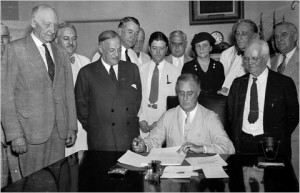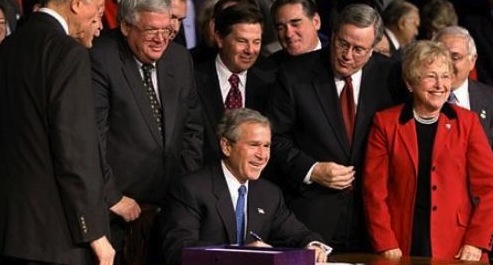Understanding My Medicare
History of Medicare
HISTORY OF MEDICARE
A SHORT HISTORY OF SOCIAL SECURITY, MEDICARE AND MEDICAID
Social Security

Social Security Act, President Franklin Delano Roosevelt on August 14, 1935
The Social Security Act had a modest beginning as signed by President Franklin Delano Roosevelt on August 14, 1935. But just about every administration since Roosevelt has played a part in expanding benefits and widening the pool of qualifiers. This trend began with Old-Age Insurance, followed by Survivors Insurance in 1939, and Disability Insurance, which President Eisenhower signed in 1956. In 1974, President Nixon added Supplemental Security Income (SSI) for low-income workers. The original Social Security mandate was also expanded to include Medicare and Medicaid.
Medicare

Lyndon B. Johnson
On July 30, 1965, as part of his “Great Society” program, President Lyndon B. Johnson signed into law the Social Security Amendment of 1965. This new law established the Medicare and Medicaid programs, which were designed to deliver health care benefits to the elderly and the poor. Medicare was initially designed to provide health care benefits for people 65 and older and their dependents, regardless of income or medical history. The Social Security Amendment of 1972 expanded the program to include individuals under age 65 with permanent disabilities and people suffering from end-stage renal disease (ESRD). In 2001, eligibility expanded further to cover people with Lou Gehrig’s disease.
The Medicare program has two components: Hospital Insurance (HI) and Supplemental Medical Insurance (SMI). Hospital Insurance, or Medicare Part A, helps pay for inpatient hospital services, home health care, skilled nursing facilities, and hospice care.
Supplemental Medical Insurance consists of Medicare Part B and Part D. Part B helps pay for physician services, outpatient hospital care, and other services, while Part D provides subsidized access to prescription drug coverage on a voluntary basis for all beneficiaries. Premium and cost-sharing subsidies for Part D prescription drugs are also available for low-income enrollees.
Medicare Part C, also know as Medicare Advantage, serves as an alternative to traditional Part A and Part B coverage. Under the Part C option, beneficiaries can chose to enroll in a Medicare Advantage plan and receive care from a private insurance company that contracts with Medicare.
The traditional Medicare Parts A and B are based on a fee-for-service pay system. That means recipients can receive care from any provider that accepts Medicare’s payments, according to a fee schedule determined by Medicare. Generally, a fee is charged for each service performed by the provider and claims are managed by the federal government. Part A is free to qualified recipients, and Part B is paid by those who elect to participate in the program through a monthly premium, based upon income-level testing.
Medicare Supplement
While Medicare covers a great portion of a recipient’s needs, it was never intended to cover the full cost of one’s care. There are various deductibles, co-insurance provisions, and other coverage gaps, which are the personal responsibility of each Medicare beneficiary. In order to fill these coverage voids, private insurance companies stepped in and designed Medigap, or Medicare Supplement, insurance to cover some of the costs not encompassed by Medicare. For all states except Massachusetts, Minnesota and Wisconsin, there are now 10 standardized Medicare Supplement Plans (A, B, C, D, F, G, K, L, M and N) that were approved by the government for sale, starting June 1, 2010.
MMA 2003

The Medicare Prescription Drug Improvement and Modernization Act of 2003 (MMA 2003), signed by President George W. Bush, resulted in the most significant changes to Medicare since the program’s inception. The act preserved and strengthened the Original Medicare program, added preventive benefits, and provided extra help to people with low income and limited assets. In addition to significant material changes affecting the program and benefits, a number of other nomenclature adjustments were made:
- The traditional fee-for-service Medicare program, consisting of Part A and Part B, was renamed Original Medicare;
- The Medicare Part C program, Medicare + Choice, was renamed Medicare Advantage (MA), which greatly expanded choices of private health plans to Medicare beneficiaries;
- And, for the first time, a new voluntary outpatient prescription drug plan benefit was introduced under the name Medicare Part D (PDP).
The introduction of these new products has greatly changed the landscape of health insurance for seniors. Both Part D outpatient prescription drug benefits and MA coverage are delivered through private plans that contract with Medicare. Instead of the fee-for-service approach, Medicare pays a fixed, monthly per-person payment to the Medicare-approved private MA plan. The MA provider then pays the Medicare beneficiary’s health care bills. The benefits must be equal to or better than the Original Medicare Plan.
Medicare Part C
The Health Maintenance Organization (HMO) Act of 1973 authorized federal Medicare payments to HMOs. In 1982, the Tax Equity and Fiscal Responsibility Act created a more meaningful alliance with Medicare making it more attractive for HMOs to contract with Medicare. Thus, Medicare recipients were allowed to receive their medical care from a private company rather than through a traditional fee-for-service.
The Balanced Budget Act of 1997 (BBA) authorized the expansion of the Medicare + Choice programs, which added additional managed care choices for Medicare recipients. In addition to HMOs, Medicare Part C plans could include Preferred Provider Organizations (PPOs), Private Fee-For-Service plans (PFFS), Provider-Sponsored Organizations (PSOs), Medical Savings Accounts (MSAs) and Fraternal Plans. These plans gave Medicare recipients a wider choice for how they could receive their Medicare-covered services.
An important provision of MMA 2003 was the creation of Regional Preferred Provider Organizations (RPPOs) and the expansion of PFFS plans, which are designed to give people in rural areas access to MA programs similar to those in urban areas. Special Needs plans (SNPs) were also authorized for people with chronic conditions, including “dual-eligibles” who qualify for both Medicare and Medicaid.
Another major change came about with a financial incentive for MA companies in the form of increased “benchmark” payments from Medicare, as compared to the payments Medicare would pay under its own fee-for-service formula. These incentives worked well. As of September 2010, 11.8 million Medicare beneficiaries, nearly one-quarter of the total Medicare population, are enrolled in Medicare Advantage (MA) plans.
Medicare Part D
With the passing of MMA 2003, the voluntary Medicare Part D program was introduced to nearly 44 million Medicare beneficiaries and the American health care and insurance industries.
- On December 8, 2003 the bill became law
- On January 21, 2005 CMS established the final rules
- In May 2005 the Social Security Administration began sending out notices to beneficiaries informing them that they may be eligible for a low-income subsidy to assist with the Part D premium and co-payment.
- On October 15, 2005 CMS sent information to all Medicare beneficiaries describing the Part D program. The initial enrollment period was defined as November 15 to May 15, 2006, and the Part D benefit began January 1, 2006.
These PDP’s are sold as either a stand-alone policy or as part of a Medicare Advantage plan (MA-PD). Part D plans are required to provide a “standard” benefit (or one that is equivalent) and may provide enhanced benefits. Individuals with modest income and assets are eligible for additional assistance with premiums and cost-sharing amounts. Part D is funded by general revenues, beneficiary premiums, and state payments. There are now more than 32 million seniors and Americans with disabilities enrolled in Part D Plans.
Medicaid
While Social Security and Medicare continue to provide a basis for financial security after retirement, they do have inherent limitations. Medicaid is a joint state and federal program that provides a safety net for those who are truly impoverished, regardless of age or disability. The program is only available to certain low-income individuals, families and State Children’s Health Insurance Program (SCHIP) beneficiaries. Those who qualify can apply to Medicaid for assistance to cover all or part of their health care bills and insurance premiums.
THE PRESENT: MEDICARE & SOCIAL SECURITY TODAY
Currently, Medicare covers 47 million people, including 30 million people age 65 and older and 8 million people under age 65 with a permanent disability. Medicare is a social insurance program, like Social Security, that offers health coverage to eligible individuals, regardless of income or health status. People pay into Medicare throughout their working lives and generally become eligible for Medicare when they reach age 65, although younger adults can also qualify if they have a permanent disability.
HOW SOCIAL SECURITY AND MEDICARE ARE FINANCED
There are four separate trust funds. Under Social Security, the Old-Age and Survivor Insurance (OASI) Trust Fund pays retirement and survivor benefits and the Disability Insurance (DI) trust Fund pays disability benefits. These two trust funds are jointly designated as (OASDI).
For Medicare, the Hospital Insurance (HI) Trust Fund pays for inpatient hospital and related care. The Supplemental Medical Insurance (SMI) Trust Fund is comprised of two separate accounts Part B, which pays for physician and outpatient services and Part D, which covers the prescription drug benefit that began in 2006.
Payroll tax rates (in percent)
OASI
DI
OASDI
HI
TOTAL
Employer – since 2009
5.30
0.90
6.20
1.45
7.65
Employee – 2011 only
3.30
0.90
10.40
2.90
13.30
Combined Total
8.60
1.80
10.40
2.90
13.30
Payroll taxes
Every American worker (155 million) pays on earnings up to $106,800 (in 2011), but not all pay income taxes. For 2011 only, President Obama signed into law payroll tax relief that reduces the employee’s OASI tax rate by 2% to 4.2%. Employers will continue to pay 6.2% for a combined rate of 10.4% for OASDI. This OASDI tax disappears on earning above $106,800. Social Security taxes are supposed to fund only OASDI benefits. Basically, it’s a forced pension tax.
The 1.45% Medicare HI tax is paid on all earnings. The self-employed are charged the equivalent of the combined employer and employee tax rates of 13.30% in 2011. In 2013, there will be an increase in the Medicare payroll tax by 0.9% on earned income in excess of $200,000 for individual taxpayers and $250,000 for married couples filing jointly. Employers do not have to match this amount.
Income tax is different in that money goes to fund all federal programs except Medicare and Social Security. About one-third of those who file federal income tax returns end up owing no federal income tax. In contrast, the top 1% of income earners – who receive 21% of the nation’s reported income pays 30% of the federal income tax. The top 5% pay 60% and the top 50%, pay 97% of federal income tax.
All taxes
Most working people’s take-home pay is reduced by Social Security, Medicare, federal income, and unemployment taxes, along with an assortment of state and local withholdings (also state income tax). Then there are user taxes-property taxes, sales taxes and fees on just about everything being purchased or used. In addition, the employer is subject to federal corporate income tax, state and local taxes, government mandates, regulations, and another “share” of payroll taxes. For about 70% of the taxpayers in the top brackets, their total federal, state, and local tax rate exceed 40% of their income.
Let us put our over 50 years of experience to work for you!
Contact us for more information
Are you currently on Medicare? Do you want to review your options? Not on Medicare yet? Contact us to see what your options are.
For more information, feel free to contact us by filling out the form below. A representative will call, email, or mail you in regards to your Medicare insurance options, including Medicare Supplement insurance, Medicare Advantage plans & Medicare Part D plans. We do not sell or share your information.
